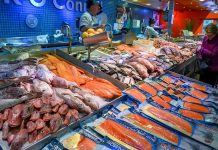Scientists have long believed that in all animals (including humans), innate physiological ability exists to seek out sources of nutrients (minerals) deficient in the major food source available to them. Their beliefs originate from a series of studies in which test animals were allowed to choose from one container of each nutrient � leading to the identification of "nutritional wisdom.� These tests proved that there is a natural disposition to select a balanced diet with all necessary nutrients and suitable for the respective environment.
Unfortunately, the nation�s soaring obesity rate offers evidence that in the animal kingdom, humans are flunking in their �nutritional wisdom.� Where nature fails to reduce weight, human ingenuity (and marketing) takes over � with a billion dollar industry advancing programs that entreat Americans to modify their habits and regain their �nutritional wisdom� and return to their �normal� and slimmer weight.
This may not be so easy and overweight Americans may be throwing their money away. New study findings suggest that �nutritional wisdom� goes out the window when unhealthy food choices are more available than healthier nutrients. Tests with rodents found that the number of containers of each nutrient provided markedly influenced consumption rates. Most rats given a choice from separate sources of protein, carbohydrate, and fat thrived if given one cup of each but half failed to thrive if given one cup of each and three extra cups of carbohydrate or fat. Rats given five bottles of sucrose solution and one bottle of water became fatter than rats given five bottles of water and one of sucrose.
These studies in rats may point to a model for human obesity, in which the availability of the wrong food can override physiological controls of ingestion. The author of "Obesity by choice: the powerful influence of nutrient availability on nutrient intake," is Michael G. Tordoff, Monell Chemical Senses Center, Philadelphia, PA. His findings appear in the current edition of The American Journal of Physiology -- Regulatory, Integrative and Comparative Physiology.
Methodology and Findings This study consisted of two distinct experiments.
Continue Reading Below ↓↓↓
(1) Influence of macronutrient choice on macronutrient selection: Thirty rats were given a choice between separate sources of solid carbohydrate (CHOW), fat, and protein, but in addition to these standard choices of nutrients, some rats received three �extra� cups of each. The experiment was terminated after eight days because four of seven rats given extra cups of carbohydrates and three of the seven given additional fat ate so little protein that they failed to survive. Providing rats with extra cups of carbohydrates or fat led to life-threatening protein malnutrition, even though the protein was freely available in the cages.
Twenty-two rats used to consuming appropriate portions of protein were reassigned to three groups: one group had a balanced selection of nutrients, another had additional carbohydrates, and the third group was provided additional fat. After 20 days, the researchers found that the test animals consumed more of the additional nutrients made available, at a cost of a balanced diet.
(2) Influence of sucrose solution choice on energy intake and obesity. This experiment attempt to influence the body weight of female rats through manipulating their access to a sucrose solution. Over a 35-day period, rats were either given just one bottle of water, or five bottles of water and one bottle of 32 percent sucrose solution, and the third group received one bottle of water and five bottles of the sucrose solution.
The researchers found that the rats with five sucrose bottles drank significantly more sucrose and consumed more energy than did those with one bottle of sucrose. The rats with the most available sucrose decreased their food intake of other nutrients yet gained more weight as a result of their additional sugar intake. After 33 days, the control group (no sucrose) gained the least amount of fat; for the two other groups, fat increase responded to the corresponding availability of sucrose.
Conclusions
The results reveal that the more sources of a nutrient a rat has, the more it chooses to eat. The effect of nutrient availability is so powerful it overrides the healthy physiological controls of food intake. This study requires that the concept of �nutritional wisdom� be re-examined because previous studies do not consider when multiple choices of each nutrient are available.
The researchers believe that this availability-based compensation is related to the �variety effect� associated with a previous study where rats given foods of different flavors or textures overconsume relative to those provided food of one type. However, other studies have found that the variety effect may only have a transient effect and not lead to obesity. This study presents an argument that simply providing multiple sources of food stimulates intake and thus may contribute to, and in some cases account for, the variety effect.
The findings in this study have long-term and significant relevance for animal husbandry, wildlife management, and the supermarket shopping habits for millions of Americans. In the last decade, the focus on controlling obesity has been on the physiological causes for this disorder � all possibility attributed to genetic makeup, hormonal differences, and neurotransmitters involved in ingestion and body weight. These findings suggest that this may be the wrong direction for addressing obesity. Availability of food, and not the physiological actions of the body, is the culprit of �obesity by choice.�
Source: American Journal of Physiology -- Regulatory, Integrative and Comparative Physiology, May 2002. The American Physiological Society (APS) was founded in 1887 to foster basic and applied science, much of it relating to human health. The Bethesda, MD-based Society has more than 10,000 members and publishes 3,800 articles in its 14 peer-reviewed journals every year.
Source: American Physiological Society
Continue Reading Below ↓↓↓









